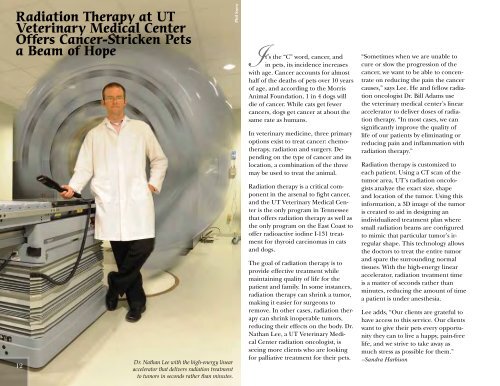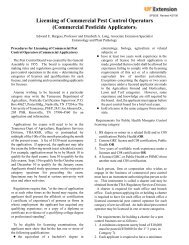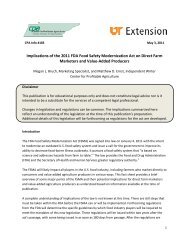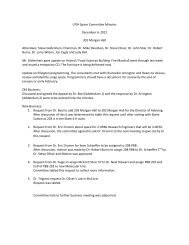Volume 8, Number 1 â Spring/Summer 2011 - The University of ...
Volume 8, Number 1 â Spring/Summer 2011 - The University of ...
Volume 8, Number 1 â Spring/Summer 2011 - The University of ...
You also want an ePaper? Increase the reach of your titles
YUMPU automatically turns print PDFs into web optimized ePapers that Google loves.
Radiation <strong>The</strong>rapy at UTVeterinary Medical CenterOffers Cancer-Stricken Petsa Beam <strong>of</strong> Hope12Dr. Nathan Lee with the high-energy linearaccelerator that delivers radiation treatmentto tumors in seconds rather than minutes.Phil SnowIt’s the “C” word, cancer, andin pets, its incidence increaseswith age. Cancer accounts for almosthalf <strong>of</strong> the deaths <strong>of</strong> pets over 10 years<strong>of</strong> age, and according to the MorrisAnimal Foundation, 1 in 4 dogs willdie <strong>of</strong> cancer. While cats get fewercancers, dogs get cancer at about thesame rate as humans.In veterinary medicine, three primaryoptions exist to treat cancer: chemotherapy,radiation and surgery. Dependingon the type <strong>of</strong> cancer and itslocation, a combination <strong>of</strong> the threemay be used to treat the animal.Radiation therapy is a critical componentin the arsenal to fight cancer,and the UT Veterinary Medical Centeris the only program in Tennesseethat <strong>of</strong>fers radiation therapy as well asthe only program on the East Coast to<strong>of</strong>fer radioactive iodine I-131 treatmentfor thyroid carcinomas in catsand dogs.<strong>The</strong> goal <strong>of</strong> radiation therapy is toprovide effective treatment whilemaintaining quality <strong>of</strong> life for thepatient and family. In some instances,radiation therapy can shrink a tumor,making it easier for surgeons toremove. In other cases, radiation therapycan shrink inoperable tumors,reducing their effects on the body. Dr.Nathan Lee, a UT Veterinary MedicalCenter radiation oncologist, isseeing more clients who are lookingfor palliative treatment for their pets.“Sometimes when we are unable tocure or slow the progression <strong>of</strong> thecancer, we want to be able to concentrateon reducing the pain the cancercauses,” says Lee. He and fellow radiationoncologist Dr. Bill Adams usethe veterinary medical center’s linearaccelerator to deliver doses <strong>of</strong> radiationtherapy. “In most cases, we cansignificantly improve the quality <strong>of</strong>life <strong>of</strong> our patients by eliminating orreducing pain and inflammation withradiation therapy.”Radiation therapy is customized toeach patient. Using a CT scan <strong>of</strong> thetumor area, UT’s radiation oncologistsanalyze the exact size, shapeand location <strong>of</strong> the tumor. Using thisinformation, a 3D image <strong>of</strong> the tumoris created to aid in designing anindividualized treatment plan wheresmall radiation beams are configuredto mimic that particular tumor’s irregularshape. This technology allowsthe doctors to treat the entire tumorand spare the surrounding normaltissues. With the high-energy linearaccelerator, radiation treatment timeis a matter <strong>of</strong> seconds rather thanminutes, reducing the amount <strong>of</strong> timea patient is under anesthesia.Lee adds, “Our clients are grateful tohave access to this service. Our clientswant to give their pets every opportunitythey can to live a happy, pain-freelife, and we strive to take away asmuch stress as possible for them.”–Sandra Harbison
















